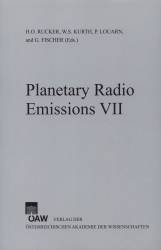
Planetary Radio Emissions VII, pp. 471-472, 2011/12/28
Proceedings of the 7th International Workshop on Planetary, Solar and Heliospheric Radio Emissions held at Graz, Austria, September 15–17, 2010

We present recent studies on large-scale solar coronal waves (so-called ”EIT waves”) obtained with the EUVI instruments onboard the twin STEREO spacecraft. EUVI has several advantages for coronal wave studies: a) high cadence full-disk imaging, which allows us to catch the wave evolution and kinematics, b) a large field-of-view, which allows simultaneous observations of the erupting CME, and c) observations from two vantage points, which enable us to get insight into the threedimensional structure of the wave. The present understanding is basically split into different groups of ”wave” versus ”non-wave” interpretations of the physical process behind the phenomenon, as well as ”flare” versus ”CME” for the driving agent. We will present the first observations of the full three-dimensional wave dome in the event of January 17, 2010. The study of the perturbation characteristics and the associated high-frequency radio type II bursts provide evidence for a weakly shocked fast-mode wave as the underlying physical process.